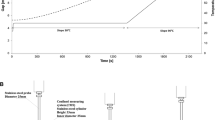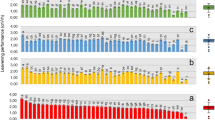Abstract
A low glycaemic index (GI) in bakery products can be associated with a decrease of cardiovascular disease and a protective role against the development and management of non-insulin-dependent diabetes. In this study, the impact of different Saccharomyces cerevisiae strains applied to the bread-making process on the GI of bread was investigated. The GI was measured using an in vitro enzymatic model system in relation to the metabolic patterns of the different yeast strains and the compositional analysis of the breads. Although total and resistant starch contents of the breads were similar, a significant reduction in GI was obtained for breads fermented with S. cerevisiae s-23, wb-06 and Blanc. Differences in the amount of protein and fat were observed. However, their proportion when related to carbohydrate content was not high enough to effectively alter the GI of the breads. Considering the fermentation process, S. cerevisiae wb-06, Blanc and to some extent s-23 were characterised by slower fermentation rates. The resulting breads were reduced in GI with lower specific volumes as well as firmer crumb structures. Breads high in GI were either characterised by an increased glucose content (S. cerevisiae us-05) or high specific bread volumes and soft crumbs (S. cerevisiae Baker’s yeast and T-58) indicating a relationship between complete starch gelatinisation during baking and starch digestibility. Conclusively, the GI of white wheat bread can be significantly decreased using different strains from the species S. cerevisiae.


Similar content being viewed by others
Abbreviations
- GI:
-
Glycaemic index
- S. :
-
Saccharomyces
- HPLC:
-
High performance liquid chromatography
- DAD:
-
Dioden array detector
- RID:
-
Reflective index detector
- RSR:
-
Reducing sugars released
- DNS:
-
3,5-Dinitrosalicylic acid reagent
- TAC:
-
Total available carbohydrates
- AUC:
-
Area under the curve
- HI:
-
Hydrolysis index
- cfu:
-
Colony forming units
- TPA:
-
Texture profile analysis
- AWCD:
-
Average well colour development
References
Jenkins DJA, Wolever TMS, Taylor RH et al (1981) Glycemic index of foods: a physiological basis for carbohydrate exchange. Am J Clin Nutr 34:362–366
Jenkins DJA, Wolever TMS, Jenkins AL et al (1986) Low glycemic response to traditionally processed wheat and rye products: bulgur and pumpernickel bread. Am J Clin Nutr 43:516–520
Dewettinck K, Van Bockstaele F, Kühne B et al (2008) Nutritional value of bread: influence of processing, food interaction and consumer perception. J Cereal Sci 48:243–257. doi:10.1016/j.jcs.2008.01.003
Björck I, Liljeberg H, Östman E (2000) Low glycaemic-index foods. Br J Nutr 83:S149–S155. doi:10.1017/S0007114500001094
Borczak B, Sikora E, Sikora M, Van Haesendonck I (2011) The impact of sourdough addition to frozen stored wheat-flour rolls on glycemic response in human volunteers. Starch/Stärke 63:801–807. doi:10.1002/star.201100055
Åkerberg A, Liljeberg H, Björck I (1998) Effects of Amylose/Amylopectin Ratio and Baking Conditions on Resistant Starch Formation and Glycaemic Indices. J Cereal Sci 28:71–80. doi:10.1006/jcrs.1997.0173
Liljeberg HGM, Lönner CH, Björck IME (1995) Sourdough fermentation or addition of organic acids or corresponding salts to bread improves nutritional properties of starch in healthy humans. J Nutr 125:1503–1511
Björck I, Liljeberg Elmståhl H (2003) The glycaemic index: importance of dietary fibre and other food properties. Proc Nutr Soc 62:201–206. doi:10.1079/PNS2002239
Fardet A, Leenhardt F, Lioger D et al (2006) Parameters controlling the glycaemic response to breads. Nutr Res Rev 19:18–25. doi:10.1079/NRR2006118
Singh J, Dartois A, Kaur L (2010) Starch digestibility in food matrix: a review. Trends Food Sci Technol 21:168–180. doi:10.1016/j.tifs.2009.12.001
De Angelis M, Rizzello CG, Alfonsi G et al (2007) Use of sourdough lactobacilli and oat fibre to decrease the glycaemic index of white wheat bread. Br J Nutr 98:1196–1205. doi:10.1017/S0007114507772689
De Angelis M, Damiano N, Rizzello CG et al (2009) Sourdough fermentation as a tool for the manufacture of low-glycemic index white wheat bread enriched in dietary fibre. Eur Food Res Technol 229:593–601. doi:10.1007/s00217-009-1085-1
Haralampu SG (2000) Resistant starch—a review of the physical properties and biological impact of RS3. Carbohydr Polym 41:285–292. doi:10.1016/S0144-8617(99)00147-2
Burton P, Lightowler HJ (2006) Influence of bread volume on glycaemic response and satiety. Br J Nutr 96:877–882. doi:10.1017/BJN20061900
Heitmann M, Zannini E, Arendt EK (2015) Impact of different beer yeasts on wheat dough and bread quality parameters. J Cereal Sci 63:49–56. doi:10.1016/j.jcs.2015.02.008
Brennan CS, Tudorica CM (2008) Evaluation of potential mechanisms by which dietary fibre additions reduce the predicted glycaemic index of fresh pastas. Int J Food Sci Technol 43:2151–2162. doi:10.1111/j.1365-2621.2008.01831.x
Hager A-S, Czerny M, Bez J et al (2013) Starch properties, in vitro digestibility and sensory evaluation of fresh egg pasta produced from oat, teff and wheat flour. J Cereal Sci 58:156–163. doi:10.1016/j.jcs.2013.03.004
Wolever TM, Jenkins DJ (1986) The use of the glycemic index in predicting the blood glucose response to mixed meals. Am J Clin Nutr 43:167–172
Praphailong W, Van Gestel M, Fleet GH, Heard GM (1997) Evaluation of the Biolog system for the identification of food and beverage yeasts. Lett Appl Microbiol 24:455–459. doi:10.1046/j.1472-765X.1997.00057.x
Henry RJ, Saini HS (1989) Characterization of cereal sugars and oligosaccarides. Cereal Chem 66:362–365
Berti C, Riso P, Monti LD, Porrini M (2004) In vitro starch digestibility and in vivo glucose response of gluten-free foods and their gluten counterparts. Eur J Nutr 43:198–204. doi:10.1007/s00394-004-0459-1
Fardet A, Hoebler C, Baldwin PM et al (1998) Involvement of the protein network in the in vitro degradation of starch from spaghetti and lasagne: a microscopic and enzymic study. Reprod Nutr Dev 27:133–145. doi:10.1006/jcrs.1997.0157
Arvidsson-Lenner R, Asp N-G, Axelsen M et al (2004) Glycaemic index. Scand. J Nutr 48:84–94. doi:10.1080/11026480410033999
Ross SW, Brand JC, Thorburn AW, Truswell AS (1987) Glycemic index of processed wheat products. Am J Clin Nutr 46:631–635
Brand JC, Nicholson PL, Thorburn AW, Truswell AS (1985) Food processing and the glycemic index. Am J Clin Nutr 42:1192–1196
Siragusa S, Di Cagno R, Ercolini D et al (2009) Taxonomic structure and monitoring of the dominant population of lactic acid bacteria during wheat flour sourdough type I propagation using Lactobacillus sanfranciscensis starters. Appl Environ Microbiol 75:1099–1109. doi:10.1128/AEM.01524-08
Lappi J, Selinheimo E, Schwab U et al (2010) Sourdough fermentation of wholemeal wheat bread increases solubility of arabinoxylan and protein and decreases postprandial glucose and insulin responses. J Cereal Sci 51:152–158. doi:10.1016/j.jcs.2009.11.006
Scazzina F, Del Rio D, Pellegrini N, Brighenti F (2009) Sourdough bread: starch digestibility and postprandial glycemic response. J Cereal Sci 49:419–421. doi:10.1016/j.jcs.2008.12.008
Wolter A, Hager A-S, Zannini E, Arendt EK (2014) Influence of sourdough on in vitro starch digestibility and predicted glycemic indices of gluten-free breads. Food Funct 5:564–572. doi:10.1039/c3fo60505a
Randez-Gil F, Sanz P, Prieto JA (1999) Engineering baker’s yeast: room for improvement. Trends Biotechnol 17:237–244. doi:10.1016/S0167-7799(99)01318-9
Nilsson U, Öste R, Jägerstad M (1987) Cereal fructans: hydrolysis by yeast invertase, in vitro and during fermentation. J Cereal Sci 6:53–60. doi:10.1016/S0733-5210(87)80040-1
Atkinson FS, Foster-Powell K, Brand-Miller JC (2008) International tables of glycemic index and glycemic load values: 2008. Diabetes Care 31:2281–2283. doi:10.2337/dc08-1239.J.B.M
Acknowledgements
The authors want to thank Tom Hannon and Maya Wiestner for technical support. This work was supported by the Seventh Framework Program of the European Community for research, technological development and demonstration activities (Grant Number 606198).
Author information
Authors and Affiliations
Corresponding author
Ethics declarations
Conflict of interest
The authors declare no conflict of interest. The founding sponsors had no role in the design of the study; in the collection, analyses, or interpretation of data; in the writing of the manuscript, and in the decision to publish the results.
Compliance with ethics requirements
This article does not contain any studies with human or animal subjects.
Rights and permissions
About this article
Cite this article
Heitmann, M., Axel, C., Zannini, E. et al. Modulation of in vitro predicted glycaemic index of white wheat bread by different strains of Saccharomyces cerevisiae originating from various beverage applications. Eur Food Res Technol 243, 1877–1886 (2017). https://doi.org/10.1007/s00217-017-2894-2
Received:
Revised:
Accepted:
Published:
Issue Date:
DOI: https://doi.org/10.1007/s00217-017-2894-2




